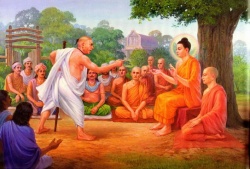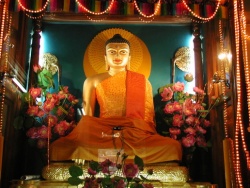Theravada and Mahayana: Parallels, Connections and Unifying Concepts by Venerable Jinabodhi Bhikkhu
Abstract: Buddhism comprises divergent schools of thought and world-view. Amidst this spectrum of philosophical tenets, the most widely known and representative schools are Theravada and Mahayana. Scholars and researchers most often tend to view these schools as schisms and highlight differences between them. Although contrasting elements are prominent and readily identifiable tenets , it is affinities and common features in them that are more worthy of examination. It is the points of resemblance and common grounds that will serve to unify philosophical views and forge solidarity among Buddhist communities of the world. The elements and features that are common in both traditions can be enumerated as follows. Mahayana and Hinayana or Theravada are both dedicated and committed to well-being of oneself and all the sentient beings of the universe. Liberation from suffering is the goal of both.
The orientation of Theravada is ethical while that of Mahayana is ethical and metaphysical. The pure Land Sect of Mahayana school of Buddhist philosophy assigns no fixed path to its followers and devotees. Hence, there are scopes to adapt to, and adopt, some of the tenets of Theravada by practitioners of Mahayana.The Pure Land Sect of Mahayana emphasises faith. Such emphasis on faith is noticeable in Theravada as well. One of the ten qualities of paramita or perfection leading to the exalted state of Arhat or Buddhahood is resolution, which is impossible to attain without faith. In both Mahayana and Theravada the ideal saint is called the Arhat, who has annihilated all passions and desires. In Mahayana the Arhat embodies Buddha nature, more keen on salvation of others than his own salvation. The doctrine of Pratitya Samutpada or conditionality and dependent origination of beings is central to the canonical text of Theravada Abhidhammapitaka. Nagarjuna , the founding figure of Mahayana, prominently analyses this concept of conditionality and dependent origination in his treatise Madhamnika –Karika and pays a glowing tribute to the Buddha as the teacher of the doctrine of Pratitya Samutpada. Nagarjuna, the exponent of Mahayana, has identified the law of causation with the highest truth. Theravada emphasises this as well.Another aspect of Buddhist philosophy is eradication of impure, unwholesome desires that appears in the doctrines of both Theravada and Mahayana.
The Pali term for faith is saddha. A mental attribute that is faith in the Buddha’s enlightenment. The doctrine of karma considers it a wholesome state of mind indispensable to attain the first stage of holiness sotapatti when a Buddhist devotee with unwavering faith breaks the fetter of doubt. Faith equips mind with confidence and determination necessary to cross the sea of Samsara. An ideal Buddhist can balance faith with wisdom. Noble disciples of the Buddha are termed the faith–devoted (Saddhanusari in Pali) and faith-liberated (Saddha-Vimutta in Pali). The canonical text of Visuddhi Magga refers to noble person as a faith-devotee or faith-liberated one. Examination of faith can be a common ground to correlate Theravada and Mahayana. The notion of nirvana, extinction of desire clinging to existence expressed in Theravada and Mahayana, implies certain parallel views. In Theravada nirvana is conceived of as freedom from desire and delusion. In Mahayana nirvana is attainment of perfection of knowledge that results from extinction of delusion stressed in Theravada. Thus nirvana, in both philosophical traditions, is conditional on absolute freedom from delusion. Since Mahayana is more liberal and open-ended than Theravada it can encompass many ideas and insights of Theravada system of belief. Buddhists believe in the unity of all human beings. Hence it should be their moral obligation to treat Theravada and Mahayana as traditions not mutually exclusive or incompatible versions of Buddhism. Instead, their aim should be to identify aspects shared by these two traditions as complementary and allied schools in order to unify diverse and divergent Buddhist philosophical views.
The history of the Buddhism is the chronicle of its expansion and ramifications into two major schools such as Theravada and Mahayana. The ethical and philosophical teachings of the Buddha assumed two distinct forms of Buddhism such as Theravada and Mahayana during the rule of King Koniskha of Kushan dynasty. But the leading Buddhist scholars, thinkers and social activists of the present century realize the necessity of forging a new order of understanding, affinity, fraternity, co-existence, unity and harmony. They are keen to put substantial emphasis on synthesis of two doctrines and tenets, highlighting the common features and principles on which the noble edifice of Buddhism rests. This modern tendency might be viewed as Buddhist liberalism aimed to unite the segregated sects and schools of Buddhism in order to endure and flourish against the proliferation of antagonistic, alien faiths, creeds and religious Buddhist communities. As the influential Buddhist scholar P.V. Bapat holds, “Buddhism is a religion of kindness, humanity and equality”. (India and Buddhism, 1976, page.1) it is imperative for us to reconcile the differences between two schools and forge closer links between them. The major point of differences between Theravada and Mahayana is the ideal of the Arahant, the enlightenment of the disciple esteemed in Theravada and the ideal of Buddhahood attainable by all, emphasized in Mahayana. Despite the two different ultimate goals of enlightenment, the adherents of Buddhism can meet and work together bearing in mind the spirit of the fraternity, kinship, harmony and solidarity of world Buddhism. The two distinct ideals of Arhathood (of Theravada) and Buddhahood (of Mahayana) need not prove a permanent insurmountable barrier or barricade between the followers of two schools of Buddhism. The success of this endeavour depends on the change of attitude and mind- set among the practitioners and devotees of Buddhism. To use the parlance of Business Studies, the two sects should make equal efforts to come out of their individual cocoons of isolation, segregation and common ground to form a joint venture or merger of religious enterprises.
There are certain differences of doctrinal tenets between Theravada and Mahayana that can be glossed over in order to achieve the unity and harmony of World Buddhism. One such doctrinal point of differences is the view of Pragga held by the followers of Theravada and Pragga as conceived by the adherents of Mahayana. Pragga is the most esteemed goal to attain Nirvana among Theravada Buddhists. But the Mahayana community associates Pragga with compassion. Pragga without compassion for suffering beings is valueless in Mahayana. This point of divergence regarding Pragga should not create too wide a gap to heal between the devotees of Theravada and Mahayana. Mahayana is more liberal and flexible in its ideological framework, allowing a scope of homage to a multitude deities and divinities like Avalokiteshawra, Manjusree, Padmapari. Such practice of homage to deities is thought to be alien to Buddhism among the followers of Theravada. This point of difference could also be disregarded in order to achieve greater harmony and solidarity. Another point of difference between Theravada and Mahayana is the Trikaya theory or the concept of the three bodies or aspects of Buddha (Buddha as eternal universal consciousness, Buddha as the body of bliss and Buddha as the body of transformation) as conceptualized in the latter branch of Buddhism. If this concept of Trinity is interpreted in figurative, metaphorical and symbolic terms, this point of disagreement can easily be overcome to reach the necessary stage of amity and harmony. Another point of departure is deification of Buddha by Mahayanists. Mahayana has exalted Mahayana. Buddhahood to a supramundane theistic position while Theravada tries to maintain monotheistic view of Buddha as a historical human figure. But the followers of Theravada and Mahayana need not remain eternally locked and trapped by the doctrinal rigidities, intricacies and complexes of each sect. Wherever differences prove to be an obstacle they should veer into a sphere of accommodation, adjustment and flexibility.
The Mahasanghikas, the precursor of Mahayana, demonstrated their differential entity in their rejection of the canonical texts of the Parivara, the Patisambhida, the Niddesa and parts of the Jataka approved in the First Council of Theravadins. The Mahasanghikas codified their own five-part caons viz. the Sutra, the Vinaya, the Ahidarma, the Dharanis and Miscellaneous. Another point of divergence between the Mahayanists and the Theravadins is the concept of the Middle Path (Modhyma-pratipat). In Theravada, the Middle Path refers to a life of moderation avoiding extremes of self-mortification or inordinate sensual indulgences. But in the Madhyamika metaphysical system which is a branch of Mahayana, the middle path signifies a theory of relativity, neither reality nor unreality of the world, neither existence, nor non-existence, neither self nor non-self. In spite of these disagreements both the Mahayanists and the Theravadins accept and uphold the basic and essential principles of Buddhism such as the four noble truths, the eightfold path, the non-existence of the soul, the theory of karma, the theory of pratitya- samudpada and thirty-seven Bodhipaksiya–dharmas. These common principles shared by the two leading schools of Buddhism should provide adequate support to bridge the gap and bring them closer than before to fashion a new order or world Buddhism. If they stress more on common ideas than on differences, they will render a signal service to the urgently-need, long-awaited emergence of World Buddhism, a harmonious synthesis of all schools, sects and denominations of Buddhism.
Theravada and Mahayana differ only in metaphysical, philosophical and transcendental topics and not in spirit. Both are dedicated to well-being of one self and all the sentient beings of the universe. Since Buddhists believe in the unity all human beings, it should not be daunting and forbidding to perceive a common ground for agreements between the two schisms of Buddhism. As the eminent Buddhist scholar Dr. Nalinaksha Dutta observed in his discerning study Aspect of Mahyana Buddhism and Its Relation to Hinayana (1930, page46), ‘Throughout the long history of Buddhism unity amidst diversity is strikingly evident. Every student or adherent of Buddhism, at all times and places, admits that Buddha taught a middle path’.
The tenets and principles manifest in both schools of Mahayana and Hinayana may be enumerated as follows:
Both schools try to get rid of attachment, hatred and delusion (raga, dvesa, moha). In practical sphere of life Buddhists of both schools are fighters against all kinds of evils arising out of thirst or craving (Tanha).
Both schools believe in the doctrine of the three characteristics of existence such as Anicca (impermanency), dukkhas (suffering) and Anatta (non-self, non-ego, absence of self, existing, real ego- entity or soul as some abiding substance).
Both schools believe in complete and permanent cessation of suffering through Nirvana. Both formulated a theory of salvation. The measures, procedures, paths in both to attain salvation may vary but stress the threefold path of sila (moral training), samadhi (mental training) and praga (wisdom) as indispensible conditions to reach the ultimate destination of Nirvana. Both adopt the theories of three types of Buddha Samyat Sambuddha, Paccheka Buddha and Sravaka Buddha. Both regard Sayamuni as Shasta. The themeof the four sublime or divine abodes such as metta (loving-kindness), Karuna (compassion), mudita (altruistic joy) and upekkha (equanimity) has been treated with great importance in both schools of Buddhism. Both schools related the four sublime mental states with the concept of parameta (perfection- qualities that lead to Enlightenment.)
A doctrinal point that may serve to reconcile the two divergent schools of Mahayana and Theravada is the concept of parami or paramita (perfection)- compendium of ten qualities in Theravada and six perfections of Mahayana. The ten perfections are (1) dana parami (perfection of giving) 92) sila parami (morality) (3) nekkhamma (renunciation) (4) pragga (wisdom) (5) viriya (energy, vigour) (6) khanti (patience) (7) sacca (truthfulness) (8) adhitthana (resolution) (9) metta (loving kindness) (10) upekkha (equanimity). The six perfections of Mahyana include dana, sila, khanti, viriya, pragga, dhyana. The eminent Mahayanist thinker Asanga propounded four perfections of satya, bairaggya, maitree, upekkhas. The perfections of two schools of Buddhism are analogues to, and identifiable with, then paramitas of Theravada are parallel to six paramitas of Mahayana. The concept of perfections could be an area to reconcile and harmonise differences.
Affinities in point of view can be instrumental in establishing a rapport and forming an alliance between the two different, mutually detached, schools of Buddhism. Further common philosophical premises that Mahayana and Theravada share are as follows. 1. Emancipation from fetters of attachment, hatred and delusion (raga, desa, moha). 2. The cosmic universe is a continuum without beginning or end (anamataggo ayam sansara). 3. All worldy beings and objects are transient (anitya), momentary (ksanika) and are in a state of perpetual flux (samantana) and are without any real substance (anatmakam). 4. The law of causation or dependent origination, the doctrine of protitya samudpada, the conditionality and dependent nature of all unsubstantial physical and psychical phenomena or elements. In Theravada this doctrine of causation is analysed in Dhamma-sangani and patthana (the first and last books of Abhidhamma-Pitaka). Its parallel enunciation in Mahayana is Nagarjuna’s treatise Madhyamika Karika where he identifies the law of causation with the highest truth and its incarnation is Buddha.
In the words of Nagarjuna: The worldly beings and objects, which arise out of causes, do not exist in reality. One who realizes this unreality of worldly beings and objects visualizes the truth and therefore visualizes the Buddha, the embodiment of truth.
We might conclude our analysis on the theme of synthesis, harmony and unity amidst diverse schools, sects and tents of Buddhism by recalling an illuminating remark on Buddhism in his A Short History of Buddhism (1980, page 126) where Edward Conze views Buddhism ‘as a spiritual’ and ‘social force’. In order to reconcile the differences and dissimilarities between Mahayana and Theravada, we should emphasize more on the spiritual, social, humanitarian aspects of universal well-being, rather than on rigid stubborn doctrinal matters. The doctrinal innovation of the Mahayana such as the switch from the Arhat-ideal of Theravada to the Bodhisatta-ideal, addition of compassion to wisdom as the noblest virtue, worship of deities, deification of Buddha, ontological view of emptiness and the introduction of a new virtue upayakausalya (skill in means) should be contained within speculative level and the polemics on these subtle, intricate issues should not be allowed to impede the bonding and closeness between two schools.
Buddha was not only a spiritual leader but also a humanist and a social reformer. During the rule of Asoka Buddhism was put into action as practical faith helping to mould society on the principles of peaceful co-existence, religious tolerance, amity, mutual understanding, harmony and solidarity. Narada opines. ‘In one sense all Buddhists are courageous warriors’ (1988:648) as warriors they fight against the evil passions of lust, hatred and ignorance. The Buddha message of non-violence and peace, of love and compassion, of tolerance and understanding of truth and wisdom of respect for all life of freedom from selfishness, hatred and violence delivered over 2500 years ago still have a continuing relevance and appeal for us in this era of globalization and information technology. The Buddhist monks and laity can translate the teachings of Buddha into concrete policies, projects and programmes to organize, promote and render social educational, cultural and other humanitarian services irrespective of race, creed and religion. They should concentrate on utilising modern state-of-the-art technology to minimize dissensions between Mahayana and Theravada, reconcile their certain differences of views and theories and help to a build a new global community of understanding, amity, harmony of World Buddhism and, to use the terms of Edward Conze, ‘set up the World Fellowship of Buddhists’ (Conze : 1980, page 104, Ashart history of Buddhism).
=
Source
=
- 1. Bapat, P.V. “India and Buddhism” in 2500 Year of Buddhism, P.V. Bapat (ed.), Publications Division, Ministry of Information and Broadcasting, Government of India, New Delhi, 1976.
- 2. Conze Edward. A Short History of Buddhism, George Allen and Unwin, London, 1980.
- 3. Dutta, Nalinaksha, Aspect of Mahayana Buddhism and Its Relation to Hinayana, Firma KLM Private Ltd. Kolkata, 1930.
- 4. Narada, The Buddha and His Teachings, Buddhist Missionary Society, Malaysia, 1988.
Source
Author: Venerable Jinabodhi Bhikkhu
buddhismandaustralia.com




